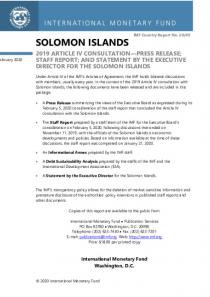On February 5, 2020, the Executive Board of the International Monetary Fund (IMF) concluded the 2019 Article IV consultation with the Solomon Islands. The consultation focused on restoring fiscal buffers to build resilience, strengthening public financial management and public investment management, setting a medium-term fiscal strategy, improving governance, improving exchange rate management and building conditions for sustainable growth.
The Solomon Islands economy grew by 3.9 percent in 2018 driven by a strong performance in logging, infrastructure spending, fisheries, agriculture, and manufacturing. However, growth slowed to 2.7 percent in 2019 from weakening logging exports and the temporary pause in economic activity around the election period. Inflation remains subdued at an annual rate of 1.7 percent in August 2019. The current account deficit has widened with higher infrastructure imports but international reserves remain comfortable. Monetary conditions are accommodative. Excess liquidity overhang has reduced, and credit growth slowed to 4.1 percent year-on-year at end of 2018. The fiscal deficit widened to 2.7 percent of GDP in 2019 and is expected to widen further over the medium term. Public debt is currently low but rises over the medium term. Risks are on the downside with weak fiscal policy, decline in logging, spending pressures associated with the Pacific Games 2023, and spillovers from global trade tensions.

